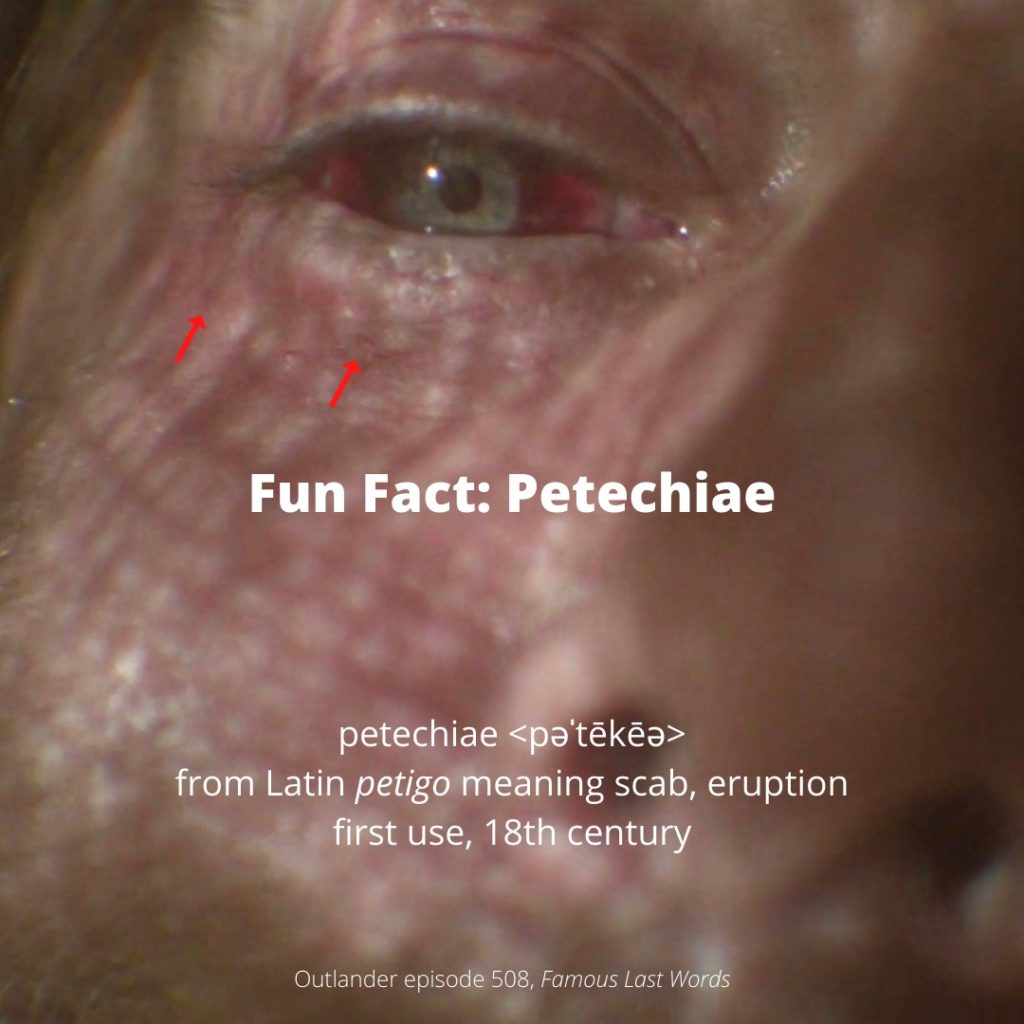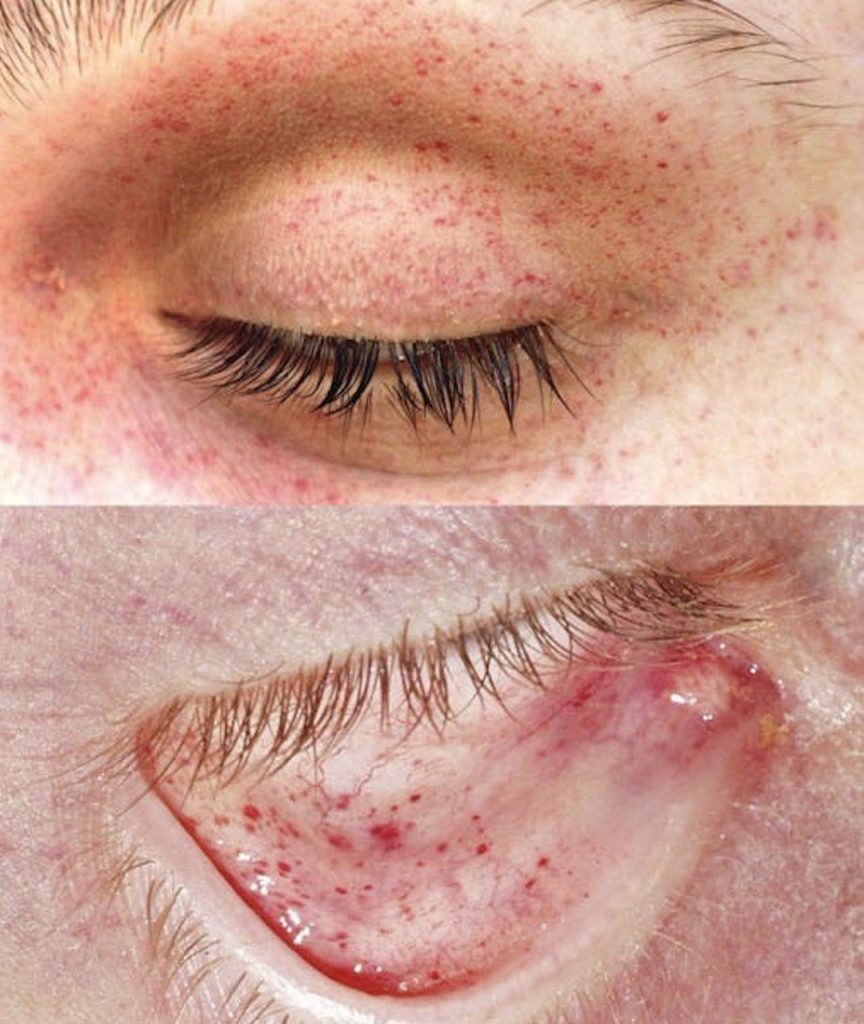
Anatomy Def: Petechiae are small round spots of blood in the skin.
Outlander Def: Telltale signs of the Roger’s distress as he slowly strangles to death!
Learn about petechiae (petechia) in Anatomy Lesson #65, Anatomy of a Hanging!
What are petechiae? Petechiae are pinpoint, round spots signaling the leakage of blood from capillaries, the tiniest blood vessels of the skin’s dermis. These often appear in clusters and may look similar to a rash.
More succinctly, petechiae are:
- Small hemorrhages (bleeding) in dermis of skin
- 1-2 mm in diameter
- Red, purple, brownish coloration
- Usually feel flat (not raised)
- Do not blanch (lose color) when pressed
What causes petechiae? Turns out there are lots of causes. Here are some general categories:
- Strenuous coughing
- Vomiting
- Giving Birth
- Lifting heavy weights
- Infections/sepsis from bacteria, fungi, viruses
- Reactions to some medications
- Blood and immune disorders
- Lack of vitamin C (scurvy)
- Lack of Vitamin K ( needed for blood clotting)
Can petechiae appear elsewhere? Well, yes! Sometimes they appear on the linings of mouth or inner eyelids (palpebral conjunctiva)! The below image compares petechiae of the skin with those of the palpebral conjunctiva.

What else causes petechiae? The answer circles us back to Outlander!
Gah! Short drop hanging may cause petechiae. In this instance, the condemned sits astride a horse, stands on a barrel or some other support; the support is suddenly removed.
The ghastly short drop may be insufficient to snap the neck so the person slowly strangles to death. They struggle for breath, blood pressure rises in the head, and capillaries burst allowing small pockets of blood to accumulate in the skin and palpebral conjunctiva. Inhumane, for sooth! Roger!!! 😱
Just so we ken, a long drop hanging (e.g. from a platform) usually snaps the neck resulting in a quick and more “humane” death (if the hangman knows his ”craft”).
Read about Roger’s hanging and its horrific aftermath in Diana’s fifth large tome, The Fiery Cross:
On a rise at the far end of the meadow stood a huge white oak, its spring leaves bright in the slanting sun. My horse moved suddenly, dodging past a group of men, and I saw them, three stick-figures, dangling broken in the tree’s deep shadow. The hammer struck one final blow, and my heart shattered like ice.
Too late.
It was a bad hanging. Without benefit of official troops, Tryon had had no one to hand with a hangman’s gruesome—and necessary—skills.
See petechiae of Roger’s facial skin (red arrows) in Outlander episode 508, Famous Last Words. Slow hanging is a ghastly way to die! 😭
Not-So-Fun Fact: Today, we can be grateful that many countries have abandoned hanging as a means of execution. If you are interested, an excellent film is available on this topic: Pierrepoint: The Last Hangman. Bonus! Tobias Menzies plays Lieutenant Llewelyn in this engrossing movie!
The deeply grateful,
Outlander Anatomist
Follow me on:
-
- Twitter @OutLandAnatomy
- Join my Facebook Group: OutlandishAnatomyLessons
- Instagram: @outlanderanatomy
- Tumblr: @outlanderanatomy
- Youtube: Outlander Anatomy
Photo credit: Sony/Starz; www.sciencedirect.com

Carmen- Once again thanks for your detailed explanation. I am a mystery fan and have often heard the term petechiae when some one is suffocated. As in the coroner is trying to determine cause of death and due to petechiae in the eyes and on the face suffocation is the explanation.
Hi Cynthia. Thank you for your note and you are welcome. I am not sure I understand your comment. Do you think there is an inconsistency here? There are a number of causes of petechiae in the living as the FF mentions – I didn’t discuss petechiae in death as Roger was rescued after a low-drop hanging and administered a life saving cricothyroidotomy (tracheotomy in TFC). As for the dead, petechiae can indicate death by manual strangulation, hanging, smothering or suffocation. But, this is in death and not the object of the fun fact. It is important to note that the petechial hemorrhages have the same distribution in the dead: on the skin and the inside of the eyelids. This is a pretty technical but good article on the topic. https://www.ncbi.nlm.nih.gov/pubmed/15749353
Thought too little or too much iron could cause this also ?
Hi Wendy. Yes, you are right! Insufficient iron can cause petechiae or even purpura. Because this is known as iron deficiency anemia, it is considered a blood disorder. I didn’t list those separately because there are quite a few just under the general category. Thanks! 🤗
I was thinking about your critique almost the whole “hanging” part of the episode Karmen knowing you would clinically describe every detail for us! Great job, looking forward to the rest. So what do you think Claire used for the tracheostomy, (is that the right word?) a piece of macaroni she just happened to have in her kit? Lol
Good morning Suzie! Thank you for your comment. Yes, there will be more blood! 🙂 More about the hanging. After Claire does the tracheotomy, she puts something temporary into the hole; then, it became a tracheostomy. So the hole is the -otomy and something to breathe through inserted into the hole becomes an -ostomy. I cannot see what she used at first. But., then, she cleans the stem of a pipe with alcohol and inserts it into the hole as a more “permanent” tracheostomy. TFC states that the pipe stem was from Mr. Caswell’s imported English pipe! 🤗 Stay tuned. There will be more blood!
Subconjunctival hematoma next? I am always impressed with Outlander attention to these details!
Yes, Anne, that is the plan! 🙂 And, yes, I am also impressed.